“I must study politics and war that my sons may have liberty to study mathematics and philosophy. My sons ought to study mathematics and philosophy, geography, natural history, naval architecture, navigation, commerce, and agriculture, in order to give their children a right to study painting, poetry, music, architecture, statuary, tapestry, and porcelain.”
– John Adams, 1780
In Pioneer’s ongoing series of blogs here, here, here, and here on curricular resources for parents, families, and teachers during COVID-19, this one focuses on:
Introducing K-12 schoolchildren to great works of art about, from, or in Massachusetts
Great Massachusetts paintings, folk, and fine arts are often not fully explored in the Bay State’s K-12 education system, so we’re offering a variety of resources to help parents, teachers, and schoolchildren, including:

“King Philip,” illustration published in The Pictorial History of King Philip’s War, circa. 1851
“King Philip’s War, also known as Metacom’s War or the First Indian War, was an armed conflict between English colonists and the American Indians of New England in the 17th century. It was the Native-American’s last major effort to drive the English colonists out of New England. The war took place between 1675-1676 in Rhode Island, Connecticut and Massachusetts and later spread to Maine and New Hampshire. The war is named for King Philip, also known by his Wampanoag name of Metacom, who was the son of the late Wampanoag chief Massasoit.”
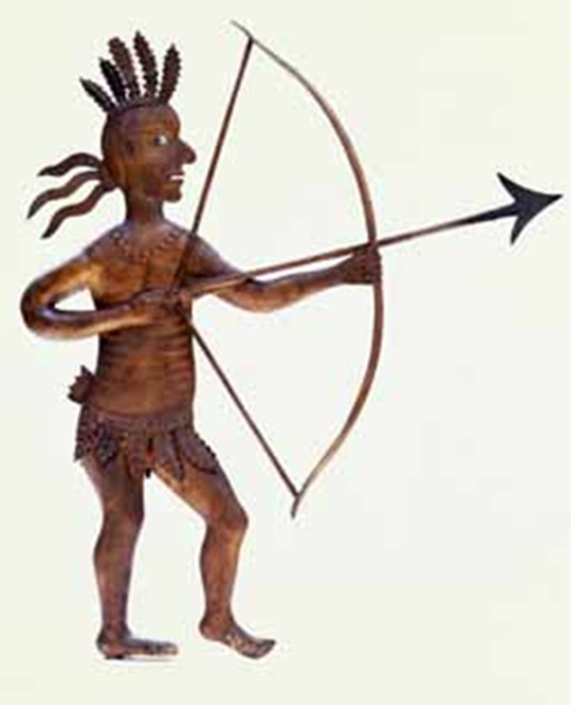
“The Indian archer weathervane,” in copper by Shem Drowne, circa. 1716, Massachusetts Historical Society, Boston, MA
“This “Indian archer” copper weathervane was crafted by Shem Drowne and installed atop the Province House in Boston around the time the house was purchased for use as the official residence of the provincial governors of Massachusetts in 1716.”

“Mayflower in Plymouth Harbor,” painting by William Halsall, 1882, Pilgrim Hall Museum, Plymouth, MA
“Mayflower in Plymouth Harbor,” oil painting by William Halsall of the ship that in December 1620 brought Pilgrims from Plymouth, England, to New England, where they established the Massachusetts colony.”

“Trial of George Jacobs Accused of Witch Craft, August 19, 1692”, painting by Tompkins H. Matteson, 1855, Peabody Essex Museum, Salem, MA
“The painting was created by Tompkins H. Matteson in 1855, and is based on the accounts of George Jacobs' granddaughter. By moving a cursor across the painting, viewers can identify Jacobs, who is being consoled by his son, also named George. The painting is entitled Trial of George Jacobs, August 5, 1692.”

“Midnight Ride of Paul Revere,” painting by Grant Wood, 1931, Metropolitan Museum of Art, NYC
“The Midnight Ride of Paul Revere” is a 1931 painting by the American artist Grant Wood. It depicts the American patriot Paul Revere during his midnight ride on April 18, 1775. The perspective is from a high altitude as Revere rides through a brightly lit Lexington, Massachusetts. It was inspired by the poem "Paul Revere's Ride" by Henry Wadsworth Longfellow. Wood used a child's hobby horse as model for Revere's horse.”
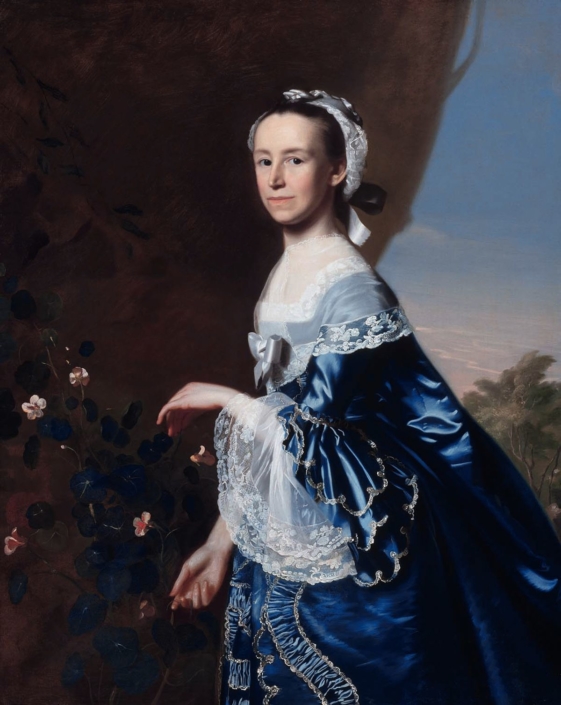
“Mrs. James Warren (Mercy Otis),” painting by John Singleton Copley, circa. 1763, Museum of Fine Arts, Boston, MA
“When Copley painted Mercy Otis Warren (1728–1814), at the age of about thirty-six or thirty-seven, she was a Plymouth, Massachusetts, housewife and mother of three sons (two more were to be born between 1764 and 1766); she would later make her name as one of the first chroniclers of the American Revolution and a dedicated campaigner for the patriot cause.”
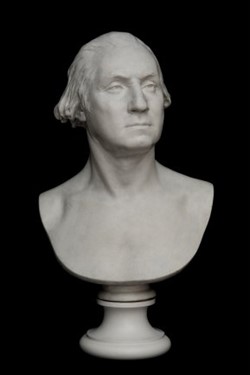
“George Washington,” bust by Jean-Antoine Houdon, 1786, Boston Athenæum, Boston, MA
“The preeminent French sculptor Jean-Antoine Houdon sailed to the United States in 1785 to fulfill a commission from the American Congress to produce an equestrian monument to George Washington… Houdon also produced busts of Washington, including this one, which established the sculptural iconography for depicting the great man for nearly every American sculptor and painter who followed. The Athenæum’s bust is not only a great example of neoclassical portraiture, it also has a stunning provenance: it was purchased in Paris by Thomas Jefferson for shipment to Monticello and, later, following Jefferson’s death in 1826, was deposited at the Athenæum by his heirs.”
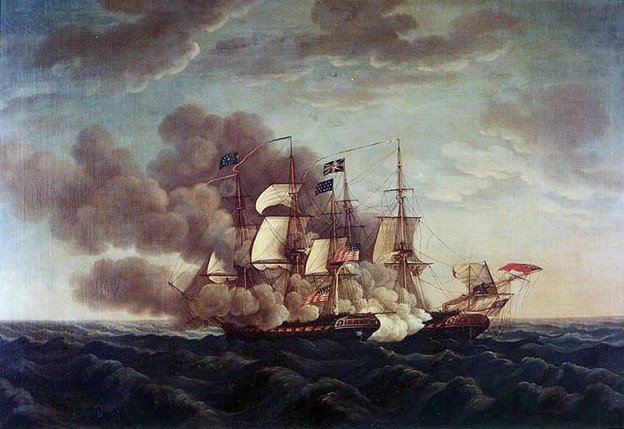
“Action Between USS Constitution vs Guerriere,” painting by Michel Felice Corne, 1812, Boston National Historical Park, Boston, MA
“USS Constitution vs. HMS Guerriere was an action between the two ships during the War of 1812, approximately 400 miles southeast of Halifax, Nova Scotia. It took place shortly after war had broken out. Guerriere had been detached from a squadron which had earlier failed to capture Constitution and was proceeding to Halifax for a refit. When Guerriere encountered Constitution again, Captain James Richard Dacres engaged, confident of victory despite the American ship being larger and more heavily armed. During the exchange of broadsides, Guerriere was dismasted and reduced to a sinking condition… Michele Felice Cornè (1752–1845) was an artist born in Elba who settled in the United States. He lived in Salem and Boston, Massachusetts; and in Newport, Rhode Island. He painted marine scenes, portraits, and interior decorations such as fireboards and murals.”
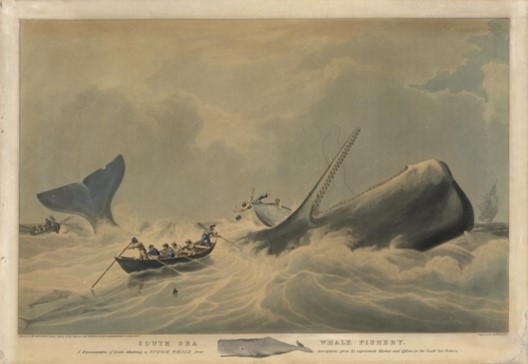
“South Sea Whale Fishery,” engraving by William John Huggins, 1834, New Bedford Whaling Museum, New Bedford, MA
“South Sea Whale Fishery” is a representation of the ships Amelia Wilson & Castor off the Island of Bouro, with their Boats & Crew, in the various process of Fishing, showing the manner the Spermaceti Whales are caught, also the mode of cutting them into the Ship & Boiling the Oil upon Deck.”
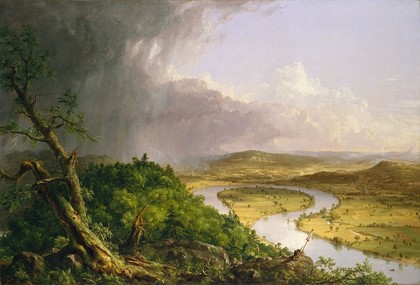
“Arts View from Mount Holyoke, Northampton, Massachusetts, after a Thunderstorm” (commonly known as “The Oxbow”), painting by Thomas Cole, 1836, Metropolitan Museum of Art, NYC
“View from Mount Holyoke, Northampton, Massachusetts, after a Thunderstorm,” commonly known as “The Oxbow,” is a seminal landscape painting by Thomas Cole, founder of the Hudson River School. The painting depicts a Romantic panorama of the Connecticut River Valley just after a thunderstorm. It has been interpreted as a confrontation between wilderness and civilization.
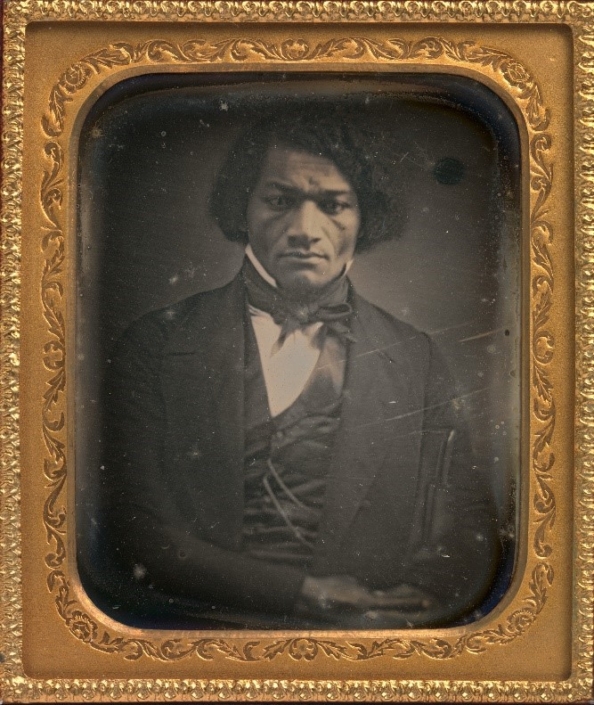
“Frederick Douglass” daguerreotype, unknown artist, circa. 1850, National Portrait Gallery, Washington, D.C.
“In the years following his escape from bondage in 1838, Frederick Douglass emerged in Massachusetts as a powerful and persuasive spokesman for the cause of abolition. Douglass’s effectiveness as an antislavery advocate was due in large measure to his firsthand experience with the evils of slavery and his extraordinary skill as an orator whose “glowing logic, biting irony, melting appeals, and electrifying eloquence” astonished and enthralled his audiences. Convinced that a peaceful end to slavery was impossible, Douglass embraced the Civil War as a fight for emancipation and called upon President Lincoln to enlist black troops in the cause.”
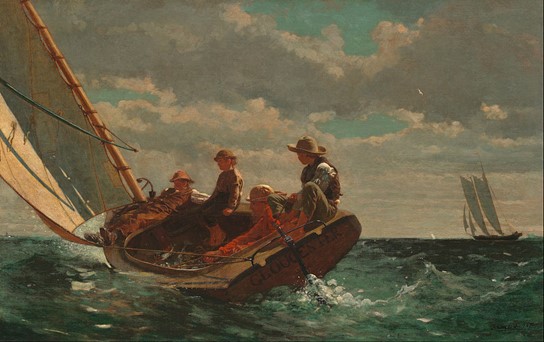
“Breezing Up (A Fair Wind),” painting by Winslow Homer, 1873–1876, National Gallery of Art, Washington, D.C.
“Breezing Up (A Fair Wind)” is an oil painting by American artist Winslow Homer. It depicts a catboat called the Gloucester chopping through that city's harbor under "a fair wind" (Homer's original title). Inside the boat are a man, three boys, and their catch.”
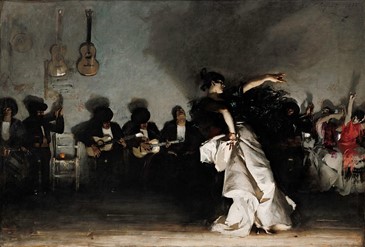
“El Jaleo,” painting by John Singer Sargent, 1882, Isabella Stewart Gardner Museum, Boston, MA
“El Jaleo” is a large painting by John Singer Sargent, depicting a Spanish Gypsy dancer performing to the accompaniment of musicians. Painted in 1882, it currently hangs in the Isabella Stewart Gardner Museum in Boston.”
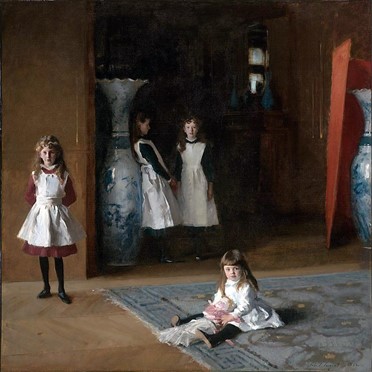
“The Daughters of Edward Darley Boit,” painting, John Singer Sargent, 1882, Museum of Fine Arts, Boston
“The Daughters of Edward Darley Boit” (originally titled “Portraits d'enfants”) is a painting by John Singer Sargent. The painting depicts four young girls, the daughters of Edward Darley Boit, in their family's Paris apartment. It was painted in 1882 and is now exhibited in the new Art of the Americas Wing of the Museum of Fine Arts in Boston.”
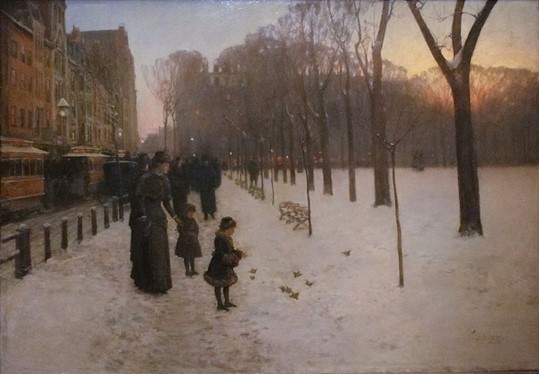
“At Dusk (Boston Common at Twilight),” by Childe Hassam, 1885-86, Museum of Fine Arts, Boston, MA
“Childe Hassam, the son of a Dorchester hardware merchant, had made only one trip to Europe before painting “Boston Common at Twilight.” He studied French art in Boston collections, and he was familiar with the popular work of painters active in Paris, like Jean Béraud and Giuseppe de Nittis, who took modern life as their main subject and frequently depicted fashionable young women in urban settings. Hassam adapted their French aesthetic to his native city and began a series of large canvases representing several of Boston’s developing neighborhoods: Back Bay, the South End, and Park Square.”
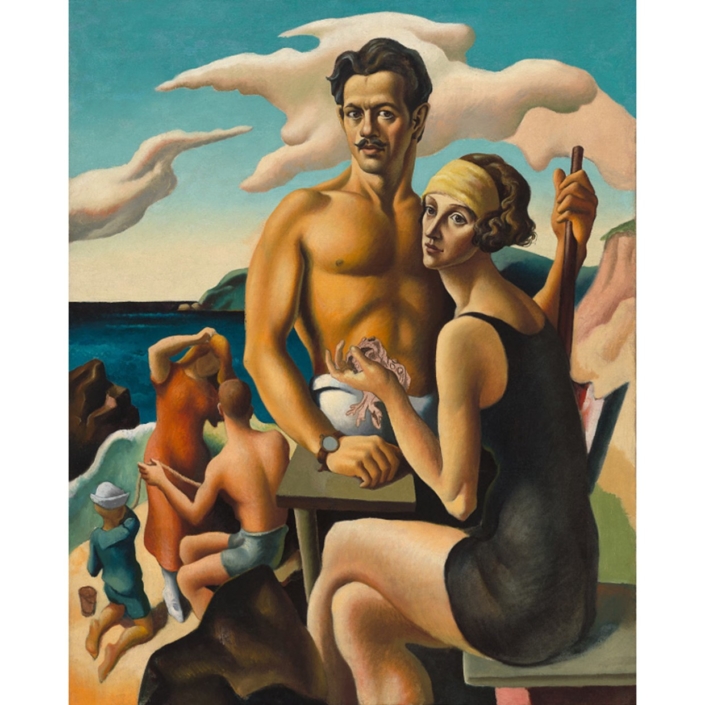
“Thomas Hart Benton with his wife Rita Piacenza Benton” (Martha’s Vineyard, MA), by Thomas Hart Benton, 1924, National Portrait Gallery, Smithsonian Institution, Washington, D.C.
“This double portrait, painted the year the artist and his wife, Rita Piacenza Benton, were married, depicts the couple on South Beach, Martha's Vineyard, Massachusetts. For Benton, Martha's Vineyard, where he spent many summers, was, "that little Massachusetts island [that] freed me from its [painting's] illusions and opened my mind to receive the great American world beyond it." In the quiet of his summer house, Benton was able to break away from modernist abstraction and forge his own representational, sculpturally conceived style.”
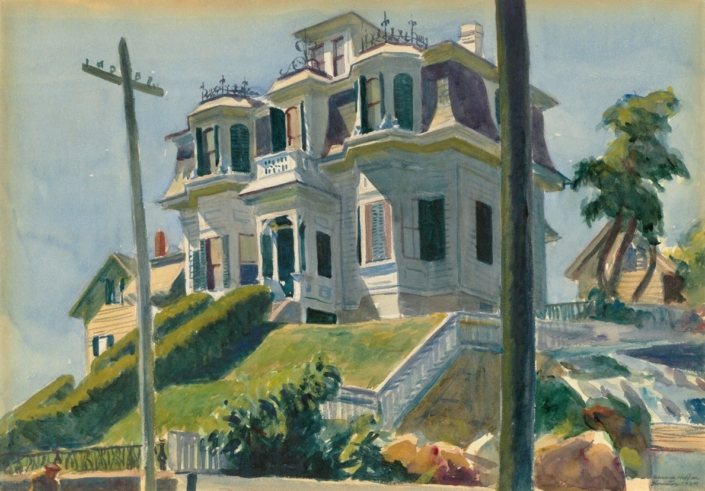
“Haskell’s House” (Gloucester, MA), painting by Edward Hopper, 1924, National Gallery of Art, Washington, D.C.
“Gloucester inspired more than 110 art works by artist Edward Hopper. A painter, printmaker, and illustrator, Hopper traveled by train from his home and studio in New York City to Gloucester, with his first visit in 1912. His signature emotive and elegant style, already evident in his prints, crystallized with his summer visits during the 1920s.”
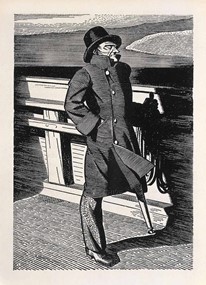
“Captain Ahab,” wood cut by Rockwell Kent, 1930, Sterling and Francine Clark Art Institute, Williamstown, MA
“Rockwell Kent large woodcut illustration of Captain Ahab from the 1930 Special Illustrated Edition of Herman Melville's Moby-Dick, illustrated by Rockwell Kent.”
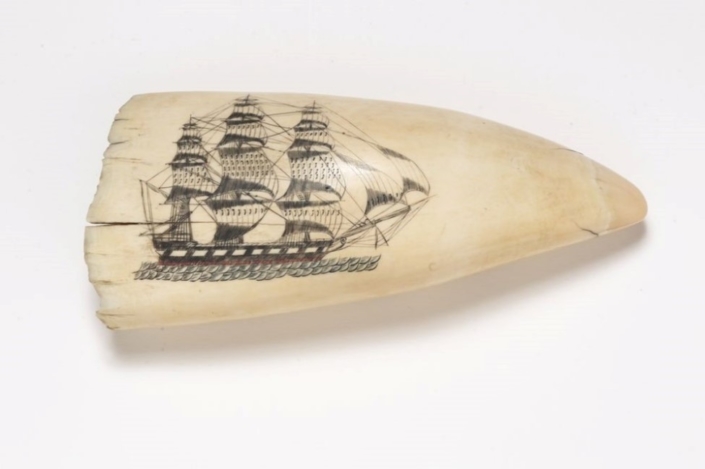
John F. Kennedy’s Scrimshaw Whale Tooth Collection, John F. Kennedy Presidential Library and Museum, Boston, MA
“Whale tooth engraved a frigate running before the wind under full sail on front. The back is engraved in black and red image a woman in a full length dress with a checkered apron holding a tiny parasol in her right hand and handkerchief in her left. It was used as a bookend in the Oval Office.”

“The Problem We All Live With” by Norman Rockwell, 1964, Norman Rockwell Museum, Stockbridge, MA
“The Problem We All Live With” is a 1964 painting by Norman Rockwell. It is considered an iconic image of the Civil Rights Movement in the United States. It depicts Ruby Bridges, a six-year-old African American girl, on her way to William Frantz Elementary School, an all-white public school, on November 14, 1960, during the New Orleans school desegregation crisis.”



